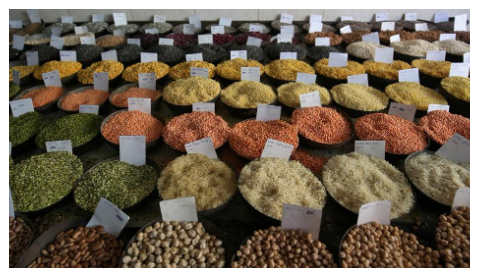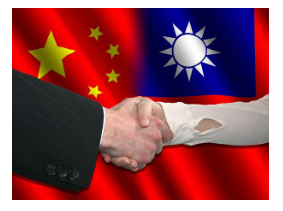Thursday, 18th January 2024
Anti Defection: Tenth Schedule
In News: The Speaker of the Maharashtra Legislative Assembly has declined to disqualify 40 MLAs belonging to the Eknath Shinde faction, having officially acknowledged it as the authentic Shiv Sena.
- Defection
- In the legislative context, a defector is an individual who relinquishes allegiance to one political party in favor of another, engaging in a perceived illegitimate change of sides.
- Defection in India
- During the 1960s and 70s, defections of legislators led to political instability in several Indian states, resulting in the downfall of elected governments.
- The 52nd constitutional amendment in 1985 introduced the 'anti-defection' law through the Tenth Schedule to ensure the stability of elected governments.
- Anti-Defection Law
- The 52nd Amendment Act of 1985 introduced Schedule 10, commonly known as the 'anti-defection law,' providing for the disqualification of members of Parliament and state legislatures for defection.
- The 91st Amendment Act in 2003 eliminated the exception provision related to defection in case of a split.
- Salient Features
- The Tenth Schedule outlines provisions for the disqualification of members based on defection, encompassing actions such as voluntarily giving up party membership, voting against party directives, and joining a political party post-election.
- Exceptions include defection resulting from a party merger or a member leaving a party after being elected as the presiding officer.
- Deciding Authority
- Questions regarding disqualification due to defection are decided by the presiding officer of the respective legislative house.
- In the Kihoto Hollohan case (1993), the Supreme Court clarified that the presiding officer functions as a tribunal, subject to judicial review for factors like mala fides and perversity.
- Benefits of Anti-Defection Law
- Promotes stability in the political landscape by curbing the tendency of legislators to switch parties.
- Facilitates democratic realignment through party mergers.
- Reduces corruption and non-developmental expenses associated with irregular elections.
- Constitutionally recognizes the existence of political parties.
- Criticism
- Lacks differentiation between dissent and defection, limiting legislators' right to dissent.
- Fails to provide for the expulsion of a legislator from their party for activities outside the legislature.
- Inconsistency in treating independent and nominated members joining a party.
- Committee Views
- Dinesh Goswami Committee suggests limitations on disqualification and vests the power of decision in the President/Governor on the advice of the Election Commission.
- Law Commission recommends deleting exceptions related to split and mergers, treating pre-poll electoral fronts as political parties.
- Judicial Pronouncements
- In the Kihoto Hollohan case, the Supreme Court upheld the validity of the law but found the provision on judicial review unconstitutional.
- In Shri Rajesh Verma v. Shri Mohammad Shahid Akhlaque, public opposition to the original party was deemed a resignation.
- In Mannadi Satyanarayan Reddy v. Andhra Pradesh Legislative Assembly, the court affirmed the Speaker's jurisdiction to decide questions related to defection.
Source: TH
Dispute Over Minority Status of AMU
In News: The Supreme Court has recently stated that an educational institution does not forfeit its minority status solely because its administration is governed by a statute.
- History of AMU
- Aligarh Muslim University (AMU) originated from the Muhammadan Anglo-Oriental (MOA) College established by Sir Syed Ahmad Khan in 1875.
- In 1920, the institution attained university status through an Act of the Indian Legislative Council, officially becoming Aligarh Muslim University (AMU).
- Origin of Dispute
- Legal challenges to the AMU Act of 1920 arose in 1967, focusing on amendments made in 1951 and 1965.
- Amendments allowed non-Muslims to participate in the University Court and altered the balance of authority within the institution.
- Supreme Court’s Ruling
- In 1967, the Supreme Court ruled that despite Muslim initiation of the university in 1920, it couldn't be considered a minority institution.
- The court emphasized that the Act was established to gain government recognition of degrees, not solely through the efforts of the Muslim minority.
- Minority Character
- The SC's 1967 ruling challenged the perception of AMU's minority character, asserting that its establishment and administration weren't exclusively rooted in the Muslim minority's efforts.
- Why Does the Dispute Persist?
- Protests following the 1967 ruling prompted a 1981 amendment affirming AMU’s minority status.
- In 2005, the Allahabad High Court nullified the 1981 Act, leading to ongoing disputes over AMU's minority status.
- In 2019, the matter was referred to a seven-judge Bench.
- Observations of the Supreme Court
- The court emphasized that regulatory statutes don't diminish an institution's minority status.
- A minority institution can have a secular administration and admit students from diverse communities.
- Presence of a majority community in administrative roles doesn't dilute minority character.
- Constitutional and Statutory Provisions Regarding Minority Communities
- Article 29 protects distinct language, script, or culture of citizens, encompassing both religious and linguistic minorities.
- Article 30 (1) empowers religious and linguistic minorities to establish and administer educational institutions.
- Article 25 protects freedom of religion, while Article 26 grants the right to establish and maintain religious institutions.
- National Commission for Minorities (NcM)
- Established in 1992, NCM advises on minority welfare and development.
- Initially, Muslims, Christians, Sikhs, Buddhists, and Parsis were recognized as minority communities, with Jains added in 2014.
- Conclusion
- Ongoing disputes over AMU's minority status highlight the complexities surrounding legal interpretations and constitutional provisions related to minority institutions in India.
|
UPSC Previous Year Questions Mains (2018) Q. Whether National Commission for Scheduled Castes (NCSC) can enforce the implementation of constitutional reservation for the Scheduled Castes in the religious minority institutions? Examine. |
Source: TH
Anganwadi Workers
In News: Anganwadi workers in Andhra Pradesh are on strike, demanding improved wages and benefits. In response, the State government has invoked the Essential Services and Maintenance Act (ESMA), 1971, against the protesting workers and helpers.
Anganwadi Services and Role of Anganwadi Workers
- ICDS Scheme and Anganwadi
- Launched on October 2, 1975, the Integrated Child Development Services (ICDS) scheme is now known as Anganwadi Services under Saksham Anganwadi and Poshan 2.0.
- A Centrally Sponsored Scheme, it focuses on early childhood care and development for children aged 0-6, pregnant women, and lactating mothers, implemented through Anganwadi workers (AWWs) and helpers (AWH).
- Services Provided by Anganwadi
- Targeted at eligible beneficiaries, including children aged 0-6, pregnant women, and lactating mothers.
- Key health services like immunization, health check-ups, and referral services are delivered through the National Rural Health Mission and Public Health Infrastructure.
- Poshan tracker, an ICT platform, monitors and captures real-time data on Anganwadi Services implementation across the country.
- Major Roles and Responsibilities of AWWs
- Community Outreach and Mobilization:
- Identifying and registering eligible beneficiaries.
- Mobilizing communities for active participation in Anganwadi activities.
- Childcare and Early Childhood Education:
- Managing Anganwadi Centers with a focus on cleanliness and hygiene.
- Providing pre-school education through play activities and basic learning.
- Monitoring growth and development, offering guidance to parents.
- Health and Nutrition:
- Distributing supplementary nutrition to combat malnutrition.
- Conducting health check-ups, facilitating immunization drives.
- Educating mothers and communities about health, hygiene, and sanitation.
Challenges Encountered by AWWs
- Meagre Remuneration:
- Anganwadi workers are not recognized as government employees, receiving low honorarium.
- Monthly payments often fall below minimum wages, leading to financial difficulties.
- Overburdened with Work:
- Assigned multiple tasks, including additional duties without extra benefits.
- Heavy workload contributes to burnout and affects service quality.
- Lack of Proper Training and Resources:
- Initial training falls short of equipping workers for daily tasks.
- Anganwadi centers often lack essential resources, hindering effective functioning.
- Lack of Social Recognition and Respect:
- Societal stigma and a lack of recognition impact morale and motivation.
- Insufficient respect for the valuable contribution to the community.
Way Forward
- Elevated Compensation and Benefits:
- Fair salary revisions aligned with the cost of living.
- Social security packages, including health insurance and maternity leave.
- Professional Growth and Recognition:
- Career progression pathways with promotion opportunities.
- Regular, intensive training programs and formalized qualifications.
- Enhanced Working Conditions and Resources:
- Optimal staffing levels with additional helpers to reduce workload.
- Modernized centers with improved infrastructure and tech-enabled solutions.
|
UPSC Previous Year Questions Prelims (2017) Q. Which of the following are the objectives of ‘National Nutrition Mission’?
Select the correct answer using the code given below: (a) 1 and 2 only Ans: (a) |
Source: TH
Shifts in Foreign Portfolio Investments in India
In News: There has been a notable reordering in the hierarchy of regions concerning foreign portfolio investments (FPIs) flowing into India.
Significant Changes in India’s FPI Landscape
- Luxembourg's Ascendancy
- Luxembourg has emerged as India's third-largest region for FPIs, surpassing Mauritius, with a 30% growth in Assets Under Custody (AUC) reaching ₹4.85 lakh crore.
- Globally, Luxembourg's equity assets are now second only to the United States.
- Strengthened India-Europe ties, reflected in three financial agreements, have contributed to Luxembourg hosting over 1,400 FPI accounts out of 3,000 in Europe (excluding the UK).
- Collaborations, especially with GIFT City, have further solidified financial ties between India and Luxembourg.
- France's Notable Gains
- France has entered the top ten FPIs with a remarkable 74% growth in AUC, reaching ₹1.88 lakh crore.
- This ascent is driven by favourable tax provisions under the Double Taxation Avoidance Agreement (DTAA) between India and France.
- Other Players in the Reshuffled Landscape
- Ireland and Norway have each climbed one position, now ranking 5th and 7th among FPI jurisdictions.
- Ireland's appeal lies in tax efficiencies and global reach, offering regulated funds exemption from Irish tax on income and gains.
- Despite a 19% year-on-year growth in AUC, Canada dropped one place in the rankings. The impact of diplomatic tensions between India and Canada on investments remains uncertain.
Foreign Portfolio Investment (FPI)
- About
- FPI refers to investments made by foreign individuals, corporations, and institutions in the financial assets of India, including stocks, bonds, and mutual funds.
- Primarily for short-term gains and portfolio diversification, in contrast to Foreign Direct Investment (FDI) involving long-term asset ownership.
- Benefits
- Capital Inflow: FPI contributes to increased liquidity and capital availability in Indian financial markets.
- Boost to Stock Market: Positive impacts on stock market valuations and increased investor confidence.
- Technology Transfer: FPI often involves investments in technology-oriented sectors, leading to technology transfer and advancements.
- Global Integration: Promotes global integration of financial markets, aligning Indian markets with global trends and attracting foreign investors.
- Risk
- Market Volatility and Capital Flight: FPI flows can be volatile due to global economic and geopolitical factors, leading to market instability and currency fluctuations.
- Transparency and Identification of Beneficial Owners: Challenges in identifying ultimate beneficiaries of complex FPI structures raise concerns about potential misuse of funds and tax evasion.
|
UPSC Previous Year Questions Prelims (2013) Q. Which one of the following groups of items is included in India’s foreign-exchange reserves? (a) Foreign-currency assets, Special Drawing Rights (SDRs) and loans from foreign countries (b) Foreign-currency assets, gold holdings of the RBI and SDRs (c) Foreign-currency assets, loans from the World Bank and SDRs (d) Foreign-currency assets, gold holdings of the RBI and loans from the World Bank. Ans: (b) Q. With reference to Foreign Direct Investment in India, which one of the following is considered its major characteristic? (2020) (a) It is the investment through capital instruments essentially in a listed company. (b) It is a largely non-debt creating capital flow. (c) It is an investment which involves debt-servicing. (d) It is the investment made by foreign institutional investors in the Government securities. Ans: (b) Mains (2016) Q. Justify the need for FDI for the development of the Indian economy. Why is there a gap between MoUs signed and actual FDIs? Suggest remedial steps to be taken for increasing actual FDIs in India. Mains (2014) Q. Foreign Direct Investment in the defence sector is now set to be liberalised. What influence is this expected to have on Indian defence and economy in the short and long run? |
Source: BL
Post-traumatic Stress Disorder (PTSD) and Cerebellum
In News: A recent study revealed that individuals diagnosed with Post-traumatic Stress Disorder (PTSD) may undergo substantial reductions in both gray and white matter volume within their cerebellum.
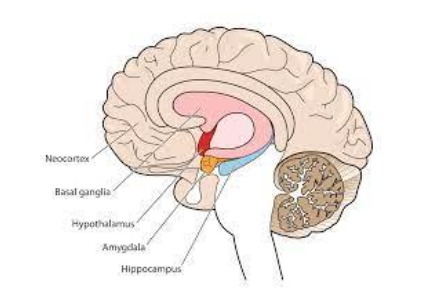
Findings of the Study
- Association with PTSD
- The study established a significant association between Post-traumatic Stress Disorder (PTSD) and notable reductions in both gray and white matter volumes in the cerebellum.
- Specific Subregions Affected
- Reductions were particularly pronounced in specific cerebellar subregions, including the posterior lobe, vermis, flocculonodular lobe, and corpus medullare.
- Correlation with PTSD Intensity
- The research demonstrated a correlation between changes in cerebellar volume and the intensity of the PTSD experience, suggesting a potential biomarker for assessing the severity of the condition.
- Challenging Traditional Understanding
- The findings challenge the conventional perception of PTSD solely as a disorder of the brain's emotion-processing centers.
- The involvement of the cerebellum suggests a more intricate disruption in the brain network associated with PTSD, encompassing regions responsible for integrating cognitive and emotional responses.
- Contribution to Understanding PTSD Pathophysiology
- The study contributes to understanding the pathophysiology of PTSD by identifying specific cerebellar regions affected by the disorder.
- Post-Traumatic Stress Disorder (PTSD)
- PTSD is a mental health condition arising after exposure to traumatic events like war, violence, abuse, or disasters.
- Symptoms include intrusive memories, nightmares, flashbacks, avoidance, and negative mood, impacting daily functioning and quality of life.
- Treatment options include psychotherapy, medication, or a combination of both.
- Cerebellum and Brain Components
- Cerebellum: Traditionally associated with motor control, the cerebellum is now recognized for its role in higher cognitive and emotional functions.
- Cerebrum: The largest brain part, responsible for interpreting sensory information, speech, reasoning, emotions, learning, and precise movement control.
- Brainstem: Acts as a relay center connecting the cerebrum, cerebellum, and spinal cord, overseeing automatic processes and reflex actions.
- Hypothalamus: Regulates functions such as body temperature, hunger, thirst, fatigue, sleep, and circadian rhythms, also influencing hormone release by the pituitary gland.
Source: DTE
Assam's Mukhyamantri Mahila Udyamita Abhiyaan
In News: The Assam government has recently launched the Mukhyamantri Mahila Udyamita Abhiyaan (MMUA), a financial assistance scheme with the goal of empowering women entrepreneurs in rural areas.
Major Points Related to the MMUA Scheme
- Objectives of MMUA Scheme
- The MMUA scheme aims to empower rural women, particularly those in self-help groups, by transforming them into "rural micro-entrepreneurs" with a targeted annual income of Rs 1 lakh per member.
- Child Limitations
- General and OBC Women: Limited to three children to qualify for the scheme.
- STs and SCs: Allowed up to four children to avail benefits.
- Moran, Motok, and 'Tea Tribes': Subject to a four-child cap.
- Additional Conditions for Beneficiaries
- Education of Girl Children:
- Beneficiaries with girl children must ensure their enrollment in school.
- For non-school-going age girls, a signed undertaking for future enrollment is required.
- Tree Plantation Drive:
- Beneficiaries are obligated to ensure the survival of trees planted under the government's tree plantation drive, Amrit Brikshya Andolan.
|
UPSC Previous Year Questions Prelims (2016) Q. Pradhan Mantri MUDRA Yojana is aimed at (a) bringing the small entrepreneurs into formal financial system (b) providing loans to poor farmers for cultivating particular crops (c) providing pensions to old and destitute persons (d) funding the voluntary organisations involved in the promotion of skill development and employment generation Ans: (a) Mains (2019) Q. ‘’Empowering women is the key to control the population growth.’’ Discuss Mains (2021) Q. “Though women in post-Independent India have excelled in various fields, the social attitude towards women and feminist movement has been patriarchal.” Apart from women education and women empowerment schemes, what interventions can help change this milieu? |
Source: HT
Guru Gobind Singh
In News: January 17 this year marks the celebration of Guru Gobind Singh Jayanti, also known as the Prakash Parv of the tenth Sikh Guru.
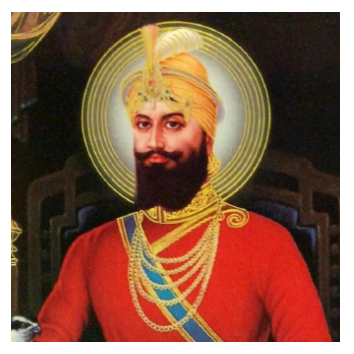
About Guru Gobind Singh
- Guru Gobind Singh was the 10th and final human Guru of the Sikhs.
- Born as Gobind Rai on December 22, 1666, in Patna, Bihar, he was the son of Guru Teg Bahadur, the ninth Guru of Sikhism.
- He assumed the role of spiritual and temporal leader of the Sikhs on November 11, 1675, at the age of nine, following the martyrdom of his father at the hands of the Mughal emperor Aurangzeb.
- Renowned as a warrior, poet, and prophet, Guru Gobind Singh is remembered as a defender of the faith and a champion of equality and justice.
- His notable contributions to Sikhism include the founding of the Sikh warrior community called Khalsa in 1699.
- He introduced the Five Ks, the articles of faith that Khalsa Sikhs wear at all times: Kesh (uncut hair), Kangha (a wooden comb), Kara (an iron or steel bracelet), Kirpan (a sword), and Kacchera (short breeches).
- Engaged in 21 battles against the Mughal Empire and their allies, including the Battle of Bhangani, Battle of Nadaun, Battle of Anandpur, Battle of Chamkaur, Battle of Muktsar, and Battle of Khidrana.
- Authored literary works in various languages, including Jaap Sahib, Tav-Prasad Savaiye, and Benti Chaupai.
- Codified Sikh law, wrote martial poetry and music, and reputedly authored the Dasam Granth (“Tenth Volume”).
- Proclaimed that he was the last of the personal Gurus, with the Guru Granth Sahib (Sikh Holy Book) becoming the Sikh Guru.
- Assassinated in 1708 at the age of 41.
- His birth anniversary is celebrated as Guru Gobind Singh Jayanti, and his death anniversary is commemorated as Guru Gaddi Diwas.
Source: LM
Kolam Tribes
In News: Under the Jan Jati Adivasi Nyay Maha Abhiyan, the Central government plans to provide essential amenities to the vulnerable Kolam tribe, emphasizing health and education.
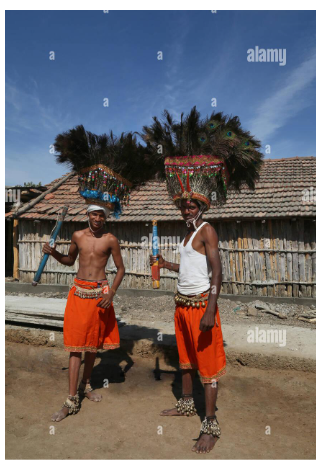
Kolam Tribes Overview
- The Kolam tribes, alternatively known as Kolamboli, Kulme, and Kolmi, inhabit a significant part of Madhya Pradesh.
- Their primary settlements are found in both plains and mountainous regions.
Geographical Distribution
- These tribal communities are recognized as scheduled tribes and extend beyond Madhya Pradesh, also residing in certain areas of Maharashtra and Andhra Pradesh.
- In Maharashtra and Andhra Pradesh, they are classified as Particularly Vulnerable Tribal Group (PVTG).
Historical Background
- Dating back to the twelfth century, Kolam individuals served as priests for the Gond, representing essential deities.
- Generally believed to be descendants of the original population in the region, their lifestyle has been influenced by the proximity to the Gond community.
Social Structure:**
- The Kolam people are organized into distinct clans, such as Chal Deve, Pach Deve, Saha Deve, and Sat Deve.
- Intra-clan marriages are prohibited, and surnames are derived from the names of their respective clans.
- Their societal structure is patrilineal, emphasizing descent through the male line.
Occupation
- Primarily engaged in agriculture and forestry, the Kolam people historically practiced shifting cultivation on hill slopes. However, contemporary life sees them settled as farmers employing plow cultivation.
Language and Communication
- The Kolam community communicates in the Dravidian language called Kolami.
- Proficiency in additional languages, including Marathi, Telugu, or Gondi, is common among adults.
Written Script
- The Kolam tribal community uses the Devanagari script for written communication.
Source: TH
Pinaka Weapon System
In News: As per statements from defense authorities, two nations in South America have expressed their interest in acquiring the Pinaka multi-barrel rocket launchers.
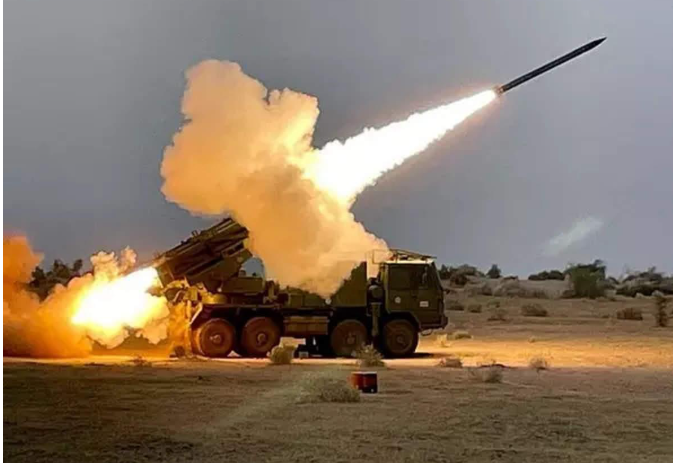
- Introduction to Pinaka
- Pinaka serves as a Multi-Barrel Rocket Launcher (MBRL) designed by the Armament Research and Development Establishment (ARDE), a unit of DRDO.
- Operational History
- It gained prominence during the Kargil War, effectively neutralizing positions held by the Pakistan Army on mountain tops.
- Target Capabilities
- Pinaka MBRL is adept at delivering potent and responsive fire, addressing diverse area targets. These include enemy troops in the open, armored and soft-skin vehicles, communication centers, air terminal complexes, as well as fuel and ammunition depots.
- Key Features
- The system comprises various components, including a multi-tube launcher vehicle, a replenishment-cum-loader vehicle, a replenishment vehicle, and a command post vehicle.
- The rocket launcher features two pods, each housing six rockets, capable of neutralizing an area spanning 700 × 500 square meters in just 48 seconds.
- During firing, the launcher system is stabilized by four hydraulically actuated outriggers.
- Range and Mobility
- Pinaka boasts an impressive operational range of 60 to 75 kilometers.
- Ensuring mobility, the system is mounted on a Tatra truck, enhancing its deployment capabilities.
Source: FP
Pakke Paga Hornbill Festival
In News: Scheduled from January 18-20, 2024, the 9th edition of the Pakke Paga Hornbill Festival (PPHF), a prominent state festival of Arunachal Pradesh, is set to be held at Seijosa in the Pakke Kessang district.
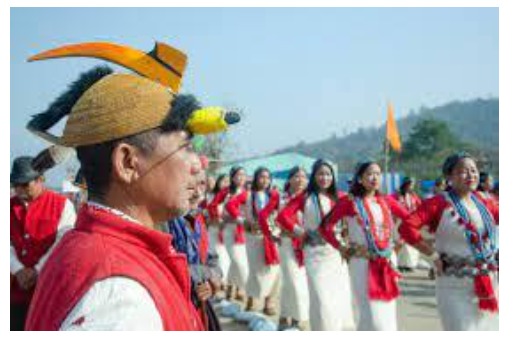
About Pakke Paga Hornbill Festival
- Inaugural Edition
- The inaugural Pakke Paga Hornbill Festival (PPHF) took place in 2015.
- Objectives
- The primary objective was to acknowledge the Nyishi tribal group's pivotal role in hornbill conservation within the Pakke Tiger Reserve (PTR).
- Additionally, the festival aimed to generate alternative sources of income for the region and raise awareness nationwide about the wonders of PTR and its surroundings.
- Theme for the Year
- The theme for this year's festival is "Domutoh Domutoh, Paga hum Domutoh," translating to 'Let Our Hornbills Remain' in the Nyishi language.
- The emphasis is on highlighting the critical importance of preserving these iconic birds.
Key Information about Pakke Tiger Reserve
- Location
- Situated in the East Kameng district of Arunachal Pradesh, PTR shares borders with the Tenga Reserve Forest to the North, Doimara Reserve Forest on the West, and Nameri National Park and Tiger Reserve (Assam) to the South.
- Ecological Significance
- The reserve occupies a unique ecological niche, characterized by high species diversity and endemicity.
- Positioned in the transition zone between the Indian and Malayan eco-regions, it plays a crucial role in maintaining biodiversity.
- Geographical Features
- Located north of the Brahmaputra River, PTR sits in the transition zone between the Assam plains and the hilly forests of Arunachal Pradesh.
- Vegetation
- The reserve boasts tropical evergreen and semi-evergreen forests, contributing to its rich ecological tapestry.
- Flora
- Prominent plant species include Polyalthia simiarum, Pterospermum acerifolium, Sterculia alata, Stereospermum chelonioides, Ailanthus grandis, and Duabanga grandiflor. Additionally, the area is home to around eight species of bamboo.
- Fauna
- PTR supports a diverse array of wildlife, including Tigers, Elephants, Leopards, Clouded Leop
- rds, and other predators.
- The reserve plays a vital role in the conservation of these species.
Source: DTE
Supreme Court's Decision Regarding Chief Secretary's Term
In News: A recent article delves into the challenges and uncertainties in the governance of the National Capital Territory (NCT) of Delhi arising from conflicts between the central government and the Delhi government.
Ongoing Tussle in NCT of Delhi Administration
- Notification of 2015
- The central government, through a 2015 notification, added Entry 41 to Article 239 AA(3(a)), granting the LG of Delhi authority in specific matters.
- The Delhi High Court upheld the exclusion of the Government of NCT of Delhi from legislating on Entry 41 - "Services."
- Supreme Court’s Invalidation
- In the case of Government of NCT of Delhi v. Union of India (2023), the Supreme Court held that Delhi has legislative and executive power over administrative services, excluding public order, police, and land.
- The concept of the "triple chain of accountability" was recognized, emphasizing civil servants' accountability to the cabinet, which is accountable to the Legislative Assembly, accountable, in turn, to the electorate.
- Central Government’s Response Post Invalidation
- The Central Government issued the Government of NCT of Delhi (Amendment) Ordinance to overrule the Supreme Court's verdict.
- The matter, referred to a Constitution Bench, led to the enactment of the Government of NCT of Delhi (Amendment) Act, 2023, granting overriding powers to the center.
Key Provisions of the Government of NCT of Delhi (Amendment) Act, 2023
- Establishment of NCCSA
- Creation of the "National Capital Civil Service Authority" with the Chief Minister as its head, influencing postings and control of civil servants.
- Role in recommending transfers and postings, excluding public order, land, and police matters.
- Section 45D Modification
- Empowers the Center regarding appointments to statutory commissions and tribunals in Delhi.
- LG's decision prevails in case of a difference of opinion.
- Bypassing Ministers
- Allows department secretaries to approach LG, Chief Minister, and Chief Secretary without consulting the concerned minister.
- Concerns with the Act
- Undermines representative democracy and responsible governance.
- Violates the SC’s judgement and constitutional principles.
- Encroaches upon federalism and state domain.
Issues in Recent Supreme Court Judgement
- Loss of Constitutional Logic
- Departure from constitutional logic raises concerns about the Court's evolving stance.
- Selective Application of Rules
- Exemption of Chief Secretary from established norms questions the Court's consistency.
- Conflict of Interest and Tenure Criteria
- Chief Secretary's conflict of interest allegations challenge the legitimacy of tenure extension.
- Role of Chief Secretary and Evading Precedents
- Contradicts past rulings on the Chief Secretary's role, creating a flawed interpretation of the law.
- Misinterpretation of Delhi Government's Position
- The Court's presumption regarding the Delhi government's desires contradicts the actual stance.
- Breakage of Accountability Chain
- Failure to recognize the breakdown in accountability perpetuates distrust in governance matters.
- Neglecting Multiple Subjects
- Overlooks Chief Secretary's involvement in various subjects under the Delhi government's jurisdiction.
Way Forward
- Expert Committee Formation
- Form an expert committee to provide recommendations on resolving the issue, considering legal, constitutional, and administrative aspects.
- Dialogue and Negotiation
- Facilitate meaningful dialogue and negotiation between central and Delhi governments for a mutually agreeable solution.
- Respect for Constitutional Principles
- Demonstrate commitment to upholding constitutional principles, ensuring fair and transparent resolution.
Conclusion
The recent Supreme Court decision raises questions about consistency and integrity, jeopardizing the balance between elected government and bureaucracy in Delhi's governance. Upholding constitutional principles is crucial for a fair resolution.
|
UPSC Previous Year Questions Mains (2015) Q1. Resorting to ordinances has always raised concern on violation of the spirit of separation of powers doctrine. While noting the rationales justifying the power to promulgate ordinances, analyze whether the decision of the Supreme Court on the issue have further facilitated resorting to this power. Should the power to promulgate the ordinances be repealed? Mains (2018) Q2. Whether the Supreme Court Judgment (July 2018) can settle the political tussle between the Lt. Governor and elected government of Delhi? Examine. |
Source: TH
Share the article
Edukemy’s Current Affairs Quiz is published with multiple choice questions for UPSC exams
MCQ
Get Latest Updates on Offers, Event dates, and free Mentorship sessions.

Get in touch with our Expert Academic Counsellors 👋
FAQs
UPSC Daily Current Affairs focuses on learning current events on a daily basis. An aspirant needs to study regular and updated information about current events, news, and relevant topics that are important for UPSC aspirants. It covers national and international affairs, government policies, socio-economic issues, science and technology advancements, and more.
UPSC Daily Current Affairs provides aspirants with a concise and comprehensive overview of the latest happenings and developments across various fields. It helps aspirants stay updated with current affairs and provides them with valuable insights and analysis, which are essential for answering questions in the UPSC examinations. It enhances their knowledge, analytical skills, and ability to connect current affairs with the UPSC syllabus.
UPSC Daily Current Affairs covers a wide range of topics, including politics, economics, science and technology, environment, social issues, governance, international relations, and more. It offers news summaries, in-depth analyses, editorials, opinion pieces, and relevant study materials. It also provides practice questions and quizzes to help aspirants test their understanding of current affairs.
Edukemy's UPSC Daily Current Affairs can be accessed through:
- UPSC Daily Current Affairs can be accessed through Current Affairs tab at the top of the Main Page of Edukemy.
- Edukemy Mobile app: The Daily Current Affairs can also be access through Edukemy Mobile App.
- Social media: Follow Edukemy’s official social media accounts or pages that provide UPSC Daily Current Affairs updates, including Facebook, Twitter, or Telegram channels.





